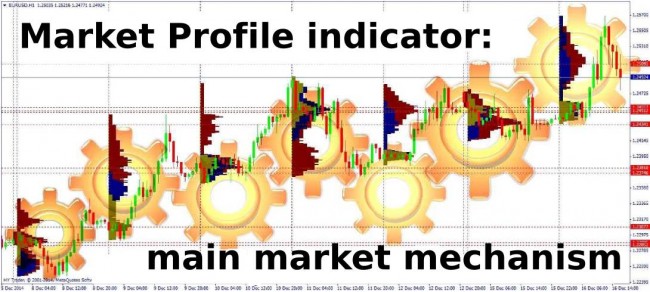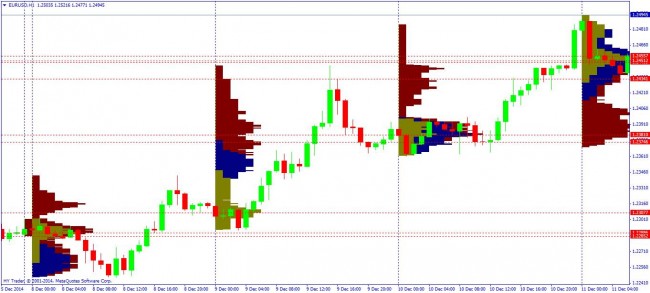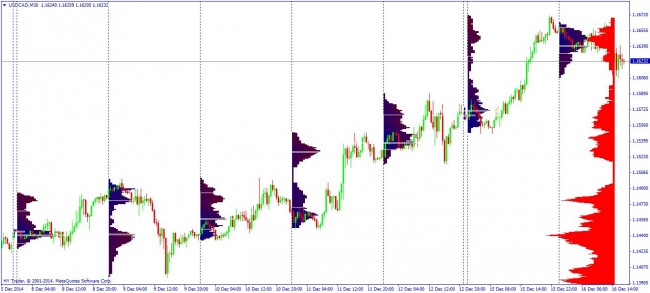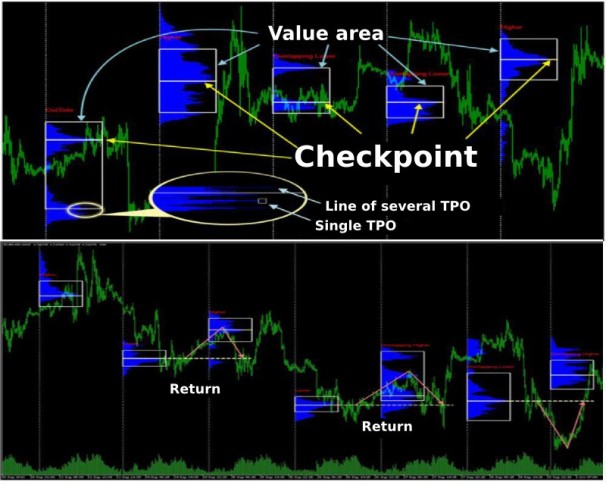Behind any price movements in the financial market there is a human with their money, goals, and psychology. Trading volume is subject to the laws of statistics, and the Market Profile indicator displays a vivid picture of the market profile in the trading terminal, with the analysis of price and volume, operating on the market in real time.
The concept of market profile was introduced by Peter Steidlmayer, who was analyzing the volume as a natural manifestation of the market and offered it in the form convenient for analysis. The Market Profile indicator processes the basic – vertical and alternative – horizontal movement of the market and displays a market profile as a bell-shaped distribution curve, turned to the price chart by 90o. It gives a lot of new models for the analysis and helps determine how your position in the market is close to the optimum (equilibrium), and also to see a program of further action of major players.
Mathematics of the market profile and types of market days
According to the classical theory, you need to analyze the M30 timeframe if you want to work by the market profile. The idea of the market profile implies the existence of some of the logical form of organization in the market, determined by price, time and volume. Mathematically, the profile building corresponds to the statistical normal distribution curve, in which 70% of the values are within the limits of one standard deviation from the average.
Every day, the market works through a certain range, called the value area – some equilibrium area, where the number of sellers corresponds to the number of buyers. Position of the current price in relation to the constructed curve gives an insight into what levels should be considered "fair", i.e. there is a real interest for them, and filter the speculative values.
Deviation from the level of a fair price at an increase in trading activity (number of contracts) indicates that the participants (buyers and sellers) overestimate the value of the current price and the movement towards equilibrium level is possible.
Instead of the usual single time slot (bar), the construction of the market profile selects the time period of 30 minutes, indicated in the diagram in Latin letters.
Installation and parameters of the indicator
Despite the fact that the indicator includes the complex calculation mechanism, its installation in the MetaTrader4(5) terminal is performed by standard procedure. In some options, the indicator script file is supplied separately and should be placed in the /expert/script directory. The indicator is used in conjunction with a conventional price chart in a main terminal window and shows the market profile of the past days and the current profile in the process of working sessions.
Important: the Market Profile indicator independently monitors the flow of prices and additionally loads technical resources, so delay and slowdown of signal processing is possible.
We should note that there are many options for indicators of market profile. Several popular are mentioned below.
On the chart: Asian (khaki), European (blue) and American (red) trading sessions.
Typically, the default values are optimal, but they can be adjusted for a particular tool.
All Market Profile indicators must be configured with the required parameters (names may be different!):
RangtCount (DaysToCount) – the number of days to build a market profile for. The more profiles you want to build, the slower the indicator will work.
StartFromDate and StartFromToday – days of beginning and end of the rendering, by default they usually start with the current date. Do not forget that the chart is based on the lines of the countdown.
Color scheme settings (ColorScheme, MedianColor, ValueAreaColor). Different price levels over time (older and more recent) are displayed in different colors.
The recommended timeframe is M30.
Price levels act as support/resistance and the price often returns to them, if the amount of the breaking the boundaries of the value area is not large enough. At the same time, this breakdown of levels with high volume marks the beginning of a strong and prolonged price movement.
The longer the "nose" of the profile, the more time the price spent on the mid-price level, i.e. the market was in a state close to equilibrium for a long time. The short profile marks an unstable market and a higher probability of movement to the adjacent strength levels.
Using Market Profile indicator in trading
After the opening of each trading day (or trading session), the most important for the trader is to accurately determine who controls the market – sellers or buyers. During the first two hours, the value area is formed, as well as possible extension beyond the original balance, i.e. the type of the current market day is determined.
The market is analyzed using two kinds of volumes: actually traded volume (amount of lots) and tick volume, which shows the dynamics of price and levels on the price chart where the price was "delayed". It helps take a side of the big players in time, when they act against the market crowd.
Important: do not forget that the market profile is built on the basis of historical data, and the basic strategy of trading is a breakdown or a rebound from the support/resistance levels.
In the process of trading, the market resorted to price breakdowns, the so-called price probes to "irritate" sellers or buyers. Strength of players’ reaction to these probes reveals strength/weakness of the specific price levels.
The following typical charts of the Market Profile indicator use the following abbreviations:
POC (point of control) – max value of the current profile
VAL (volume area low) – min 70% of the area (value)
VAN (volume area high) – max 70% of the area (value);
HVL (high volume level) – max volume.
The number of points must be chosen for each tool depending on volatility.
1. In a bearish market, if the day (session) opened lower than yesterday’s VAL, we open sell from VAL and from POC, stop above VAN.
2. In a bullish market, if the opening was above VAN, we open buy from VAH and from POC, stop below VAL.
3. In a bearish market, if the opening is inside VA, we open sell from VAN, stop at the level of POC or HVL.
4. In a bullish market, if there is an opening inside VA, we open buy from VAL, stop at the level of POC or HVL.
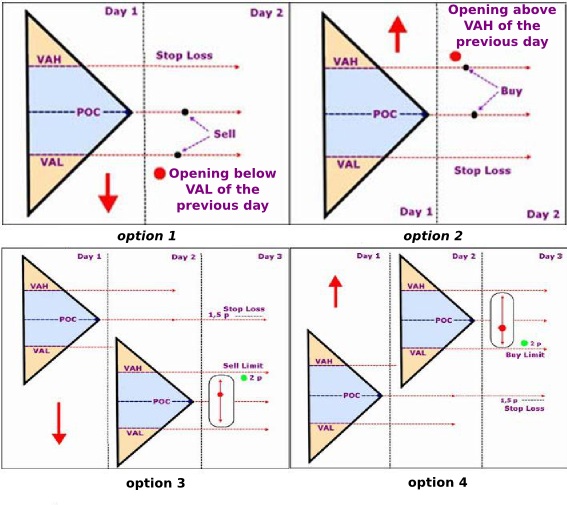
5. In a bearish market, if there is an opening above VAN but below VAL, we open sell at VAL level, and again at the HVL, stop at VAN. If the price has reached the stop but goes above, we change the direction of trading.
6. In a bullish market, if there is an opening below VAL but above VAN, we open buy at VAN level and again at HVL, stop at VAL. If the price has reached the stop but goes below, we change the direction of trading.
7. In a bearish market, if there is the opening above VAL but below the level of POC, we open sell at VAL and POC level, stop just above the max of the day before yesterday. If the price has reached the stop but goes above, we change the direction of trading.
8. In a bullish market, if there is an opening below VAN but above POC, we open buy at VAN and POC level, stop just below the min of the day before yesterday. If the price has reached the stop but goes below, we change the direction of trading.
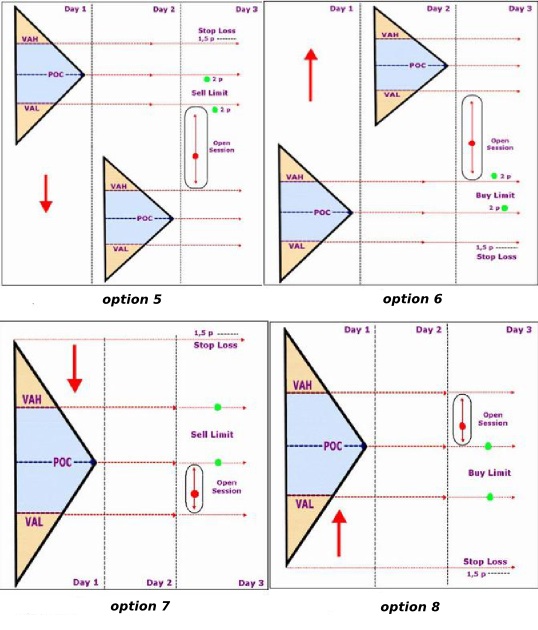
Important: always put the stops considering the levels of the previous days (VAL, VAN and POC).
The general scheme of trading by the Market Profile indicator:
And as a conclusion...
Basic concepts of market profile are necessary for any trader. This tool, developed by futures traders, provides unique market information, which was previously known only to those who work "in the hole" – in an exchange trading room. Market profile provides a visual representation of the logic and price structure of the current market, bound to time, volume and number of contracts traded.
The Market Profile indicator is not a technical indicator in its usual role. He has virtually no drawbacks and "contra", does not give buy/sell signals, but will be a useful part of any trading system, as it allows the trader to understand who and how controls the market, where the levels of the fair price are and what lies behind every market movement.
Social button for Joomla



